Nutrient-dependent requirement for SOD1 in lifespan extension by protein restriction in Drosophila melanogaster
- PMID: 22672579
- PMCID: PMC3444681
- DOI: 10.1111/j.1474-9726.2012.00842.x
Nutrient-dependent requirement for SOD1 in lifespan extension by protein restriction in Drosophila melanogaster
Abstract
Reactive oxygen species (ROS) modulate aging and aging-related diseases. Dietary composition is critical in modulating lifespan. However, how ROS modulate dietary effects on lifespan remains poorly understood. Superoxide dismutase 1 (SOD1) is a major cytosolic enzyme responsible for scavenging superoxides. Here we investigated the role of SOD1 in lifespan modulation by diet in Drosophila. We found that a high sugar-low protein (HS-LP) diet or low-calorie diet with low-sugar content, representing protein restriction, increased lifespan but not resistance to acute oxidative stress in wild-type flies, relative to a standard base diet. A low sugar-high protein diet had an opposite effect. Our genetic analysis indicated that SOD1 overexpression or dfoxo deletion did not alter lifespan patterns of flies responding to diets. However, sod1 reduction blunted lifespan extension by the HS-LP diet but not the low-calorie diet. HS-LP and low-calorie diets both reduced target of rapamycin (TOR) signaling and only the HS-LP diet increased oxidative damage. sod1 knockdown did not affect phosphorylation of S6 kinase, suggesting that SOD1 acts in parallel with or downstream of TOR signaling. Surprisingly, rapamycin decreased lifespan in sod1 mutant but not wild-type males fed the standard, HS-LP, and low-calorie diets, whereas antioxidant N-acetylcysteine only increased lifespan in sod1 mutant males fed the HS-LP diet, when compared to diet-matched controls. Our findings suggest that SOD1 is required for lifespan extension by protein restriction only when dietary sugar is high and support the context-dependent role of ROS in aging and caution the use of rapamycin and antioxidants in aging interventions.
Published 2012. This article is a U.S. Government work and is in the public domain in the USA.
Conflict of interest statement
All authors declare no conflict of interest.
Figures
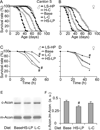
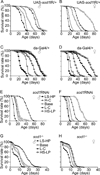

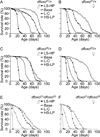
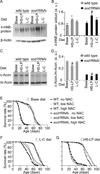
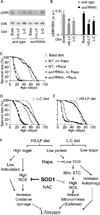
Similar articles
-
The effect of resveratrol on lifespan depends on both gender and dietary nutrient composition in Drosophila melanogaster.Age (Dordr). 2013 Feb;35(1):69-81. doi: 10.1007/s11357-011-9332-3. Epub 2011 Nov 16. Age (Dordr). 2013. PMID: 22083438 Free PMC article.
-
A botanical containing freeze dried açai pulp promotes healthy aging and reduces oxidative damage in sod1 knockdown flies.Age (Dordr). 2013 Aug;35(4):1117-32. doi: 10.1007/s11357-012-9437-3. Epub 2012 May 26. Age (Dordr). 2013. PMID: 22639178 Free PMC article.
-
Cranberry interacts with dietary macronutrients to promote healthy aging in Drosophila.J Gerontol A Biol Sci Med Sci. 2014 Aug;69(8):945-54. doi: 10.1093/gerona/glt161. Epub 2013 Oct 22. J Gerontol A Biol Sci Med Sci. 2014. PMID: 24149429 Free PMC article.
-
Role of TOR signaling in aging and related biological processes in Drosophila melanogaster.Exp Gerontol. 2011 May;46(5):382-90. doi: 10.1016/j.exger.2010.11.036. Epub 2010 Dec 2. Exp Gerontol. 2011. PMID: 21130151 Free PMC article. Review.
-
Dietary restriction in Drosophila.Mech Ageing Dev. 2005 Sep;126(9):938-50. doi: 10.1016/j.mad.2005.03.023. Mech Ageing Dev. 2005. PMID: 15935441 Review.
Cited by
-
Regulation of metabolic health by essential dietary amino acids.Mech Ageing Dev. 2019 Jan;177:186-200. doi: 10.1016/j.mad.2018.07.004. Epub 2018 Jul 22. Mech Ageing Dev. 2019. PMID: 30044947 Free PMC article. Review.
-
Aging studies in Drosophila melanogaster.Methods Mol Biol. 2013;1048:77-93. doi: 10.1007/978-1-62703-556-9_7. Methods Mol Biol. 2013. PMID: 23929099 Free PMC article.
-
Mitotype Interacts With Diet to Influence Longevity, Fitness, and Mitochondrial Functions in Adult Female Drosophila.Front Genet. 2018 Nov 30;9:593. doi: 10.3389/fgene.2018.00593. eCollection 2018. Front Genet. 2018. PMID: 30555517 Free PMC article.
-
Identification of COMMD1 as a novel lamin A binding partner.Mol Med Rep. 2019 Aug;20(2):1790-1796. doi: 10.3892/mmr.2019.10419. Epub 2019 Jun 24. Mol Med Rep. 2019. PMID: 31257505 Free PMC article.
-
Nutrigenomics as a tool to study the impact of diet on aging and age-related diseases: the Drosophila approach.Genes Nutr. 2019 May 2;14:12. doi: 10.1186/s12263-019-0638-6. eCollection 2019. Genes Nutr. 2019. PMID: 31073342 Free PMC article. Review.
References
-
- Beauchamp C, Fridovich I. Superoxide dismutase: improved assays and an assay applicable to acrylamide gels. Analytical biochemistry. 1971;44:276–287. - PubMed
-
- Burger JM, Hwangbo DS, Corby-Harris V, Promislow DE. The functional costs and benefits of dietary restriction in Drosophila. Aging Cell. 2007;6:63–71. - PubMed
Publication types
MeSH terms
Substances
Grants and funding
LinkOut - more resources
Full Text Sources
Medical
Molecular Biology Databases
Miscellaneous

